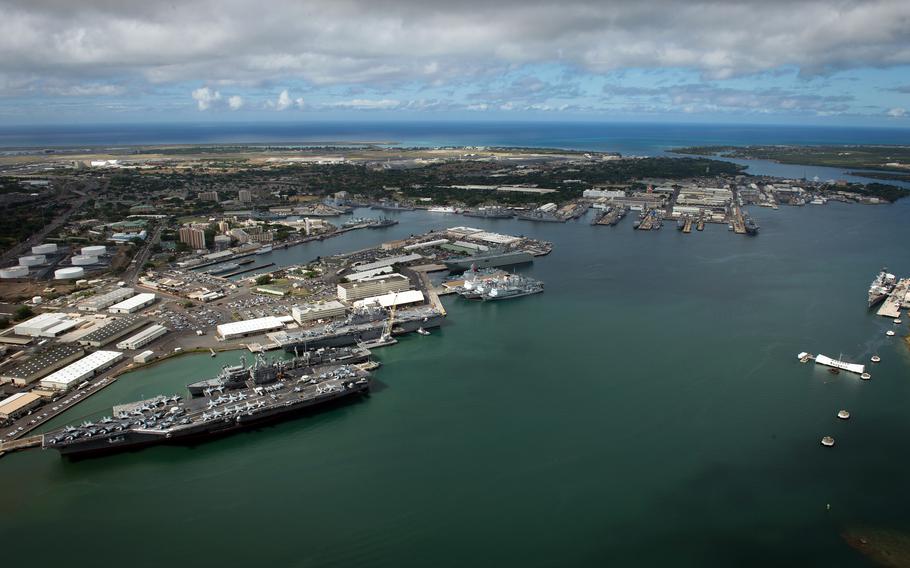
An aerial view of ships moored at Joint Base Pearl Harbor-Hickam, Hawaii, July 6, 2016. (Ace Rheaume/U.S. Navy)
FORT SHAFTER, Hawaii — The Hawaii Department of Health announced Tuesday that it would fine the U.S. Navy $8.7 million for more than 700 incidents of discharging sewage from its wastewater treatment plant on Joint Base Pearl Harbor-Hickam.
The notice of violation and order was issued “to address a myriad of deficiencies” at the Navy’s treatment plant near Pearl Harbor since the beginning of 2020, the Health Department said in a news release Tuesday.
“The Navy’s failure to properly operate and maintain this wastewater treatment plant led to the pollution of state waters,” Kathleen Ho, deputy director of environment health at the Health Department, said in the release.
“We are taking action to protect our state’s water resources and to hold the Navy accountable to make critical repairs and prevent a potential catastrophic failure of the facility,” she said.
The Navy has 20 days to request a hearing if it wishes to contest the order, according to the release.
The plant is operated by the Naval Facilities Engineering Command.
The treatment facility occupies about 12 acres and filters about 6.5 million gallons of household and industrial wastewater per day, according to a 2020 Navy fact sheet.
This is only the latest high-profile action taken by Health Department against the Navy.
In January, it ordered the service to empty and close the Red Hill fuel facility near the joint base after jet fuel contaminated groundwater.
The Navy contested the order to discontinue using the massive World War II-era collection of storage tanks, but in March Defense Secretary Lloyd Austin relented and ordered the facility permanently closed.
Regarding the wastewater plant, the Health Department “assessed an $8,776,250.00 penalty based on 766 counts of discharging pollutants in exceedance of permit limits, 17 counts of unauthorized bypass, and 212 counts of operation and maintenance failures,” the news release said.
Among the violations cited in the Health Department’s order were the Navy’s failures to operate and maintain a sand filter bypass valve, ultraviolet disinfection systems and effluent pumps. In some instances, untreated or insufficiently treated wastewater bypassed sand filters because of “poor operation and maintenance,” the release said.
The order requires the Navy to take corrective actions, including assessing the condition of the plant and following up with needed repairs, obtaining a “root cause analysis for recent effluent pump failures” and implementing a revised maintenance plan, according to the release.
The Health Department conducted an inspection of the plant on July 26 after the Navy reported an “unanticipated bypass,” and concluded that the facility was “not operated and maintained properly,” the 10-page order states.
Discharge monitoring reports submitted by the Navy to the Health Department indicate a vast problem with discharges exceeding the allowable limit of enterococci, bacteria commonly found in human and animal fecal matter that can carry disease.
The plant exceeded allowable limits on 764 days between January 2020 and through July 2022, or more than 80% of the time, the order states.
Incidents summarized in the order suggest that the Navy, referred to as “Respondent” in the document, lacked proper oversight of the operation.
On July 12, the Navy notified the Health Department that wastewater was bypassing the sand filters used to clean it because a valve was partially open.
“Respondent stated that the duration of the bypass was unknown,” the order states. “Respondent does not know why the valve was partially open nor when it was opened. Further, Respondent stated that the valve was frozen and could not be closed.”
The Navy announced in April that it had awarded a $30 million contract to a local firm for modernizing the treatment plant.
The work, which was to include replacing sludge pumps, piping, valves, controls and ventilation systems, is expected to be completed by March 2024.
"The wastewater treatment plant remains operational, and the Navy continues to improve operations at the plant," the Navy said an emailed statement Tuesday.
In June 2021, the Navy and the U.S. Environmental Protection Agency entered into a Federal Facilities Compliance Agreement calling for a series of 21 actions to address known deficiencies, the Navy said.
The service is "on track" to meet timelines on those actions, "including assessments, plans, and construction projects" that may address some of the Health Department's order, the Navy said.